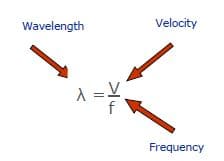Ultrasonic Velocity Chart
Check out the handy Ultrasonic Velocity Chart given in this article for an idea of the average speed of longitudinal ultrasonic waves in various materials.
Keep in mind, these are just rough estimates. The actual velocity could be vastly different due to various factors like composition, structure, porosity, temperature, and more.
This is especially so in materials like cast metals, fiberglass, plastics, and composites.
To ensure the most accurate thickness readings, it’s always best to calibrate the sound velocity in the test material by using a sample of known thickness.
Ultrasonic Testing Velocity
Ultrasonic testing is a widely used non-destructive evaluation (NDE) method for evaluating the properties of engineering materials.
The method relies on the measurement of ultrasonic waves to determine the properties of a material such as its thickness, density, and elastic modulus.
The speed at which these ultrasonic waves travel through a material is known as the ultrasonic velocity.
In this article, we will explore the ultrasonic velocity chart, including a comprehensive list of engineering materials that are tested using ultrasonic testing and the relevant topics that are covered.
Ultrasonic Velocity Chart for Materials
The below ultrasonic velocity chart lists the longitudinal ultrasonic wave velocity at which ultrasonic waves travel through different materials.
The velocity is typically given in units of meters per second (m/sec) or inches per microsecond (in./µsec).
The chart includes a wide range of materials, including metals, plastics, ceramics, liquids, and composites.
| Material | V (in./µsec) | V (m/sec) |
|---|---|---|
| Aluminum | 0.2490 | 6320 |
| Beryllium | 0.5080 | 12900 |
| Brass | 0.1740 | 4430 |
| Copper | 0.1830 | 4660 |
| Inconel | 0.2290 | 5820 |
| Iron, Cast (soft) | 0.1380 | 3500 |
| Iron, Cast (hard) | 0.2200 | 5600 |
| Iron oxide (magnetite) | 0.2320 | 5890 |
| Lead | 0.0850 | 2160 |
| Lucite | 0.1060 | 2680 |
| Molybdenum | 0.2460 | 6250 |
| Nickel, pure | 0.2220 | 5630 |
| Steel, 1020 | 0.2320 | 5890 |
| Steel, 4340 | 0.2300 | 5850 |
| Steel, 302 austenitic stainless | 0.2260 | 5740 |
| Tin | 0.1310 | 3320 |
| Titanium | 0.2400 | 6100 |
| Tungsten | 0.2040 | 5180 |
| Zinc | 0.1640 | 4170 |
| Zirconium | 0.1830 | 4650 |
| Acrylic (Perspex) | 0.1070 | 2730 |
| Composite, graphite/epoxy | 0.1200 | 3070 |
| Diamond | 0.7090 | 18000 |
| Fiberglass | 0.1080 | 2740 |
| Glycerin | 0.0760 | 1920 |
| Motor oil | 0.0690 | 1740 |
| Polyamide | 0.0870 | 2200 |
| Nylon | 0.1020 | 2600 |
| Polyethylene, high density (HDPE) | 0.0970 | 2460 |
| Polyethylene, low density (LDPE) | 0.0820 | 2080 |
| Polystyrene | 0.0920 | 2340 |
| Polyvinylchloride, (PVC) | 0.0940 | 2395 |
| Rubber, polybutadiene | 0.0630 | 1610 |
| Silicon | 0.3790 | 9620 |
| Silicone | 0.0580 | 1485 |
| Water (20 °C or 68 °F) | 0.0580 | 1480 |
Materials Tested by Ultrasonic Testing
- Metals: Ultrasonic testing is commonly used to test the properties of various metals such as aluminum, steel, titanium, and copper.
- Polymers: Ultrasonic testing is also used to evaluate the properties of polymers such as polyethylene, polypropylene, and PVC.
- Composites: Ultrasonic testing is used to evaluate the properties of composite materials, including fiber-reinforced composites and carbon fiber composites.
- Ceramics: Ultrasonic testing is used to evaluate the properties of ceramics, including aluminum oxide and zirconia.
- Glass: Ultrasonic testing is used to evaluate the properties of glass, including soda-lime glass and tempered glass.

Ultrasonic Velocity Formula
The formula for ultrasonic velocity is given by:
V = √(E/ρ)
where: V = ultrasonic velocity (m/s) E = Young’s modulus (Pa) ρ = density of the material (kg/m3)





